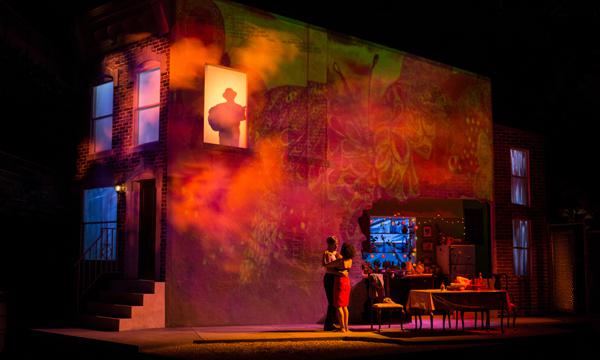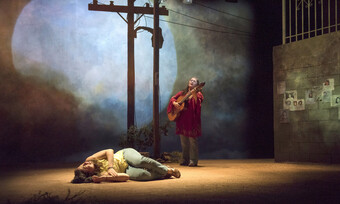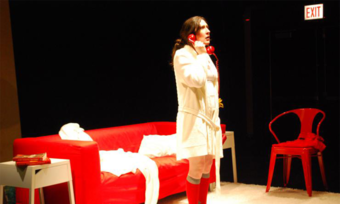The Happiest Song Plays Last at The Goodman Theatre, Chicago
What’s bubbling up under the sidewalk of the American theatre? Shifting demographics.
Institutional regional theatres cannot continue to program exclusively for an audience of white, baby boomer subscribers. That audience is moving to warmer climates. They are dying off. The Goodman Theatre appears to be paying attention to this shift.
Quiara Alegría Hudes’s newest play, The Happiest Song Plays Last, is about burying the past to embrace the responsibility of the future. Her characters engage in this hard work. And, I would argue, the Goodman’s programming of a Latino Theatre Festival in the middle of their season does too. It is not unusual for a theatre of The Goodman’s stature to produce the world premiere of a Pulitzer Prize winner’s latest play. However, it is unusual for such a play to be framed as part of an extended festival celebrating the work of Latino artists.

This is the sixth Latino Theatre Festival the Goodman has produced in recent years, and it features the Teatro Buendía production of Pedro Páramo (an artistic exchange with Cuba, co-commissioned by MCA Chicago, which played until March 31), Edward Torres’ staging of The Happiest Song Plays Last, produced in association with Teatro Vista and playing until May 12, and community-based Albany Park Theater Project’s Home/Land, playing July 18–28.
The Latino population is growing rapidly in the United States; even the Republicans are starting to address that Latinos are increasingly a political force to be reckoned with. With this programming, this large institutional regional theater reaches out to the Latino community in Chicago, welcoming it in. The curtain speech to The Happiest Song Plays Last is given first in Spanish and then in English. The production opens with musician Nelson Gonzalez, a well-known cuatro player, playing and singing jibaro music in the house. In the first scene of the play, the characters protest Arizona’s draconian racial profiling laws in both Spanish and English in the aisles of the Owen Theatre.
The Happiest Song Plays Last is the third play in Hudes’s trilogy about cousins Elliot and Yaz, which began in 2006 with Pulitzer Prize finalist Elliot, A Soldier’s Fugue and continued with Pulitzer Prize winning Water by the Spoonful. Elliot and Yaz, each on their own separate journeys, bury their ghosts and find closure.
In an impassioned speech at the beginning of the second act, Yaz orders her audience, “Take the song to those who don't know anything about it.” In many ways, the mainstream aesthetic of this production does just that. It is certainly accessible to that white, baby boomer subscriber base I expect to see at large institutional theaters like The Goodman. The storytelling is mostly linear, the acting style is realistic, and the production values are high. While Hudes’s characters occasionally speak in Spanish, as a non-Spanish speaking audience member, I do not feel like I miss out on any storytelling. The Spanish-language lyrics to the songs Gonzalez sings throughout the play are translated into English in the program. The production does not alienate a traditional subscriber base.
The central metaphor of the play is that of cracks in the sidewalk, of old rivers under the street, bubbling up, threatening to wash the present away. The pebbles of Jordan well up from the crack in the sidewalk outside the family home in Philadelphia in a set designed by Collette Pollard. Projections designed by John Boesche shine on the side of the house, invoking deserts and fields in the shape of its silhouette, but with holes where windows are bricked over, a hole where the paint is peeling away, a hole where the wall itself peels away to allow the audience to peer into the family’s kitchen. The visual continuity of the family home is broken; the central action of the play is the journey to rebuild it and make it whole.
Elliot and Yaz struggle with what it means to leave a legacy and to accept the weight of history.
Elliot and Yaz struggle with what it means to leave a legacy and to accept the weight of history. Elliot has returned to the Middle East to film a movie, re-encountering some of the experiences he initially encountered as a marine—living in the barracks, finding moments of camaraderie with others, and participating in moments of violence we quickly learn are merely fiction. He befriends an Iraqi member of the film crew and attempts to repent the sins of his past, interacting with Middle Eastern culture in ways he could not have imagined at the beginning of his journey in Elliot: A Soldier’s Fugue.
Yaz bought and moved into the family matriarch's house in North Philadelphia at the end of Water by the Spoonful. At the start of The Happiest Song, she’s mothering the neighborhood, feeding Lefty, a sweet local homeless man, who calls her “the best mom in the world,” and discovering the complexity of her newfound caretaker role.
Elliot and Yaz are in their thirties and forties, grappling with what it means to make a mark, working on fully embodying the responsibilities that come with being a fully-vested adult. Hudes’s final play in the trilogy explores what it means to own the past enough to “grow up” and face the future.
This theme is hardly new in the American theater. At intermission, Sam Shepard’s Curse of the Starving Class rang in my ear, echoing “I don’t have to pay for my past.” The crack in the sidewalk invoked, for me, Suzan-Lori Parks “great hole of history” from The America Play. But within the context of a Latino Theatre Festival at a mainstream institutional theater, The Happiest Song Plays Last seemed to ask something new about how the American theatre can examine its past and its roots and move forward in a way that legitimately invites diverse audiences.








Comments
The article is just the start of the conversation—we want to know what you think about this subject, too! HowlRound is a space for knowledge-sharing, and we welcome spirited, thoughtful, and on-topic dialogue. Find our full comments policy here
Dani, thanks for this! I LOVE the newcrit program because of the work writers like you are providing us! Keep it up!